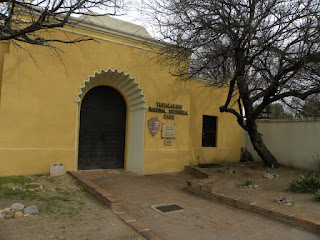We spent a half day at the Arizona Sonora Desert Museum. It has wonderful displays inside, great botanical displays outside, and a few animals in outdoor contained settings-wolves, mountain lion, bear, pecaries, etc.
 |
| Sonora Desert Museum, overview. |
The mineral, cave, geology, and mining displays were inside, down and dark.
 |
| Minerals |
A newly added aquarium complimented the aviary and hummingbird walk-in habitat.
 |
| Band-tailed Pigeon |
Twice daily there is a Raptor Free Flight program that had birds fly overhead and return to their trainers. There were so many spectators that we had to watch from afar. The birds who flew over our heads and gave a wonderful show were a Barn Owl, a group of four Harris Hawks (they hunt cooperatively), a Peregrine Falcon, and a Grey Hawk.
 |
| Crowd at the Raptor Flight, note the hawk on a Saguaro. |
One of the perches was ironic!
 |
| Harris Hawk on sculpture. |
 |
| Harris Hawk on handler's glove. |
 |
| Trail, with railings made with local mesquite wood. |
We enjoyed browsing the quality gift shop's wide variety of items.
Helen






















































